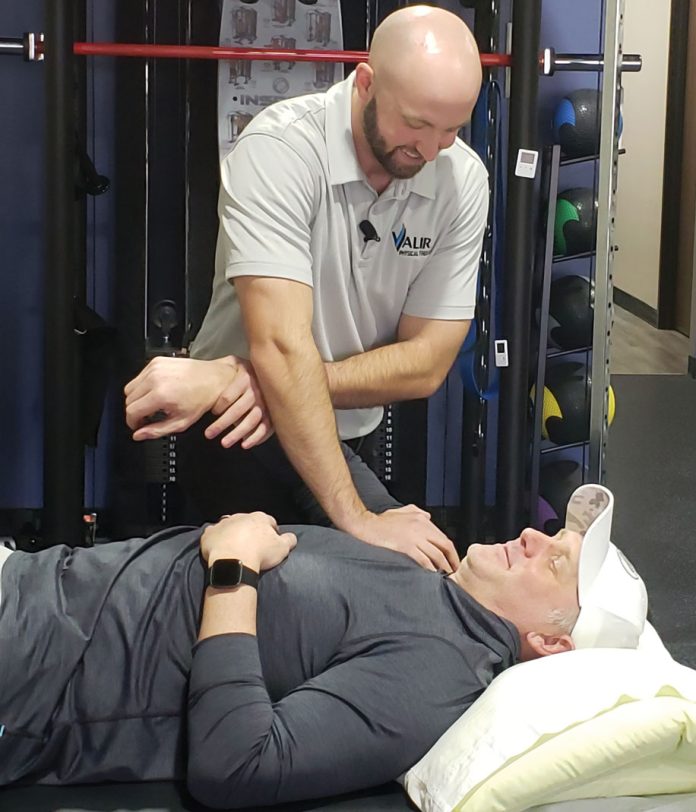Warmer weather has always been synonymous with golf for Josh Cline, but time playing golf gave way to time at Valir Physical Therapy Deer Creek.
It all started with a golf swing that didn’t go quite right.
“I was playing golf and on my follow through I felt something, and I was like, ‘That’s not right,” Cline said. “And so, I tried to walk it off and just not think about it. I played golf a couple more times and it was just like, ‘Okay, this isn’t good.”
It was not good. It turns out the pain Cline was feeling was emanating from not one but two injuries. He had suffered a torn rotator cuff and a bicep injury too. After surgery and over a month in a sling, Cline turned to Valir physical therapist Austin Inskeep to help him recover.
“Our goal is to help get patients back to full use and full mobility, and that’s different for each patient. Josh is a big golfer. He’s very active and likes to work out. So, our goal is to get him back to doing those things,” Inskeep said.
For Inskeep, the shoulder is perhaps his favorite joint because it is one of the most complicated joints in the body. Perhaps it is no wonder then that almost everyone over the age of 18 will have a shoulder issue at some point in his or her life.
More than two million Americans will experience rotator cuff injuries each year. Rotator cuff tears can happen in people of all ages but are more common in adults.
“Your rotator cuff is made up of four different muscles and then those help move the joints through different planes. And over time, those can wear out,” Inskeep explained.
He added that physical therapy can help some patients with rotator cuff injuries avoid surgery altogether, especially with less severe injury.
“We see a lot of people who go to the doctor and get x-rays and MRI’s, and everything looks great, but they might have some fraying of the rotator cuff. We can get them on a program to help strengthen their shoulder muscles and prevent further decay of that joint and often help get them back without having to have surgery,” Inskeep said.
In fact, studies have shown that a properly designed physical therapy program can help as many as 75 percent of patients with rotator cuff tears not caused by trauma avoid surgery altogether. Physical therapy also has been shown to benefit patients who retore the rotator cuff after a surgical repair with satisfaction levels and clinical outcome scores that compare well with surgical treatment.
With or without surgery, physical therapy for a Rotator Cuff injury and other shoulder injuries typically starts with passive range of motion.
“That’s followed by active assisted range of motion where the patient uses the other arm to help move that arm through different points often with a pully, cane or different apparatus.”
Next, patients like Cline move to active range of motion exercises. In those, Cline uses his shoulder joint and the muscles that surround it. The final phase of therapy focuses on strengthening muscles, including the shoulder, the back and the core because all play a role in shoulder stability and injury prevention.
Inskeep and the team at Valir PT Deer Creek work with Cline in the clinic a couple of times a week, and there is homework too.
“It’s imperative that he does exercise outside, works on the different motor coordination, the range of motion things that I give him outside of here to be the most successful,” Inskeep said.
A sports fan, Cline knows the value of teamwork, and he and Austin are a team in this recovery process.
“He’s not just checking the boxes, you know,” said Cline. “He’s really ingrained in seeing you through and wanting you to get to that that end goal of yours. So, we talk about that, you know, where do you want to be in the next few months or what do you want to be doing by this month?”
The Valir Physical Therapy team is focused on Cline’s goals too, helping him put shoulder pain and injury behind him and get back into the swing of things again, which, of course, includes golf.













